
Chichimeca meet Caldera.
1550-1590, In Mexico, Chichimeca confederation rises up against Spaniards and their allies who raid Indian villages for more slaves to work the new silver mines. Caravans taking “silver roads” south from mines to Querétaro and Guadalajara are subject to constant Chichimeca attack. The nomadic Indians avoid mass death by disease, and succeed with armor-piercing arrows, ambush tactics and newly obtained horses. They intercept many silver convoys and then turn to attacks on presidios and towns, and actually force closure of several mines.
Dominican priests blame war on unjust enslavement of Chichimeca people. A mestizo captain, Miguel Caldera, persuades viceroy to eventually withdraw soldiers, curb slave raids, increase food donations, establish new towns for Indians and emphasize peaceful conversion. The war is mostly resolved, with silver mines back in operation, by 1590.
This “Purchase for Peace” dictates a less violently aggressive attitude toward indigenous peoples on the part of New Spain’s viceroys for the next 200 years.
1551, National University of San Marcos chartered for Lima by decree of Charles I, king of Spain, May 12. Royal and Pontifical University of Mexico is also chartered by Charles, Sept. 21. They will be the second and third universities in the New World, after University of St. Thomas Aquinas in Santo Domingo, 1538.
1552, Miguel the Black (originally from Puerto Rico) leads insurrection of black slaves and Jirajira Indians working Buría river gold mines (in present-day Venezuela). They establish and defend cumbes (marron towns), attack mines to free more people and inspire hundreds to risk escape.
Spanish forces counter in 1555, killing now-King Miguel and hunting down most of the cumbe inhabitants. But slaves continue to escape from mines and plantations to create new cumbes, whose population is put at more than 20,000 in 17th century.
1552, Bayano, a Yoruban, leads insurrection shortly after disembarking in present-day Panama. Rebel slaves, called cimarrons here, soon number as many as 1,200 and name their free palenque Ronconholon. They fight off colonial governor for five years with guerrilla tactics, and alliances with Indians and pirates.
Spaniards ultimately capture Bayano and send him to Spain where he dies. But other cimarrons continue to harass Spain’s cross-Isthmus treasure mule-trains.
1553-1558, Mary, Henry VIII’s Catholic daughter by Catherine of Aragon, ascends throne, July, and moves to reverse Protestant movement launched by Henry and continued by Edward before his death at age 15.
A year later, she marries Spain’s Felipe (son of Charles I) at Winchester Cathedral. New heresy laws target Protestant nobles and bishops; 283 are ultimately executed, most by burning.
1555, Portuguese establish more slave factories on Gold Coast, including predecessor post to Cape Coast Castle, east of Elmina. Local tribes receive guns, ammunition, clothing, spices, sugar and silk. Later, large underground dungeons are dug at several factories to hold as many as 1,000 captives each for Middle Passage shipment to America.
1555, Tenamaztle, surviving Indian leader from Mexico’s Mixtón War, pleads the Caxcán case before Charles I and the Council of the Indies in Valladolid; he is assisted by De las Casas. But no record survives of trial’s outcome or Tenamaztle’s fate.
1555, Peace of Augsburg permits rulers (but not citizens) of Holy Roman nations and principalities to choose either Catholicism or Lutheranism for their lands, ending bloody religious warfare for a time.
Charles I (who is also Holy Roman Emperor Charles V) accepts the realty of the Reformation. He abdicates the following year from both Spanish and Holy Roman thrones, retires to a monastery in Spain, and dies in 1558 of malaria.
1558, Felipe II takes Charles’s place as king of Spain. Although married to Mary, queen of England, they rule their nations separately and usually apart.
Mary dies of influenza or tuberculosis, Nov. 17, and Elizabeth I ascends the throne, bound to return England to the Protestant path and soon to become Felipe’s bitter enemy.
1562, Inland Santiago de los Caballeros and La Vega are destroyed by a Dec. 2 earthquake that levels much of the fertile Cibao Valley. Plantations are ruined, and more slaves are able to escape to cimarron communities.
1562, First English slaving expedition is led by John Hawkins with three ships to Sierra Leone. More than 300 Africans are captured or bought, and transported to Spanish plantations on Hispaniola, where he trades for sugar, pearls and animal hides for return trip to England.
On a second voyage, he gathers 600 slaves to sell in Spanish Venezuela and Colombia, despite Spain’s ban on such trade (the English lack the asiento); Queen Elizabeth is an investor.
1564, Spanish King Philip II institutes convoy system to defend treasure fleets as they depart Vera Cruz and Portobelo to rendezvous at Havana. Combined fleet then sails trans-Atlantic to Seville (and later Cádiz). Fleets expand from 20 ships to 50 large galleons by end of the century and make the Spanish Empire the world’s richest and most dominant.
The convoys are devised by Pedro Menéndez de Avilés, the king’s favorite admiral and a designer of the definitive version of the treasure galleon. The great majority of treasure ships will deliver their cargo safely.
Santo Domingo’s loss: Havana is chosen as rendezvous point because of its location on the Straits of Florida, the main passage north for the Gulf Stream. Santo Domingo (and all of Hispaniola), already deserted by many settlers and bypassed by new colonists who flock to silver-rich Mexico and Peru, are thus no longer on the main trade route to Spain.
1565, St. Augustine is founded, Sept. 8, in present-day Florida by Pedro Menéndez de Avilés who, with the aid of a hurricane, defeats French Huguenots attempting their own settlement at Fort Caroline to the north (present-day Jacksonville). Menéndez orders 350 male “heretics” put to the sword, including their commander, Jean Ribault. The Spanish are determined to eliminate any threat to the treasure-laden Aramadas de la Carrera that sail the Straits of Florida on their way to Spain.
St. Augustine will be central to Florida’s 300-year history of violence among contending Spanish, British, American, Indian and escaped-slave forces. It is the oldest continuously inhabited city founded by Europeans in the present-day U.S. states.
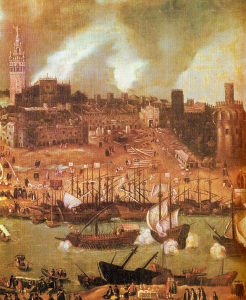
1565, Spain’s Andrés de Urdaneta discovers the north Pacific current that will take Manila galleons down California coast to Acapulco over the next 250 years. Most of his crew dies on initial 129-day passage aboard San Pedro.
Mexican silver and Spanish goods are shipped to Manila to buy Chinese porcelain, silk, jade, silk; Indian cotton and rugs; and Spice Island and Malaysian spices for the return to Acapulco.
Overland: Cargo landed at Acapulco is loaded on mule trains that climb the mountains to Mexico City. From there it goes on to Vera Cruz and the treasure fleet bound for Spain. Indians and mestizos provide most of the labor. In later years, Manila shipments are combined at Acapulco with silver from Bolivia and Peru, redirected from the Panama City-Portabelo route (vulnerable to pirates, enemy warships and raiding cimarrons.
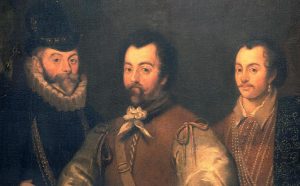
1567-1568, John Hawkins, now with cousin Francis Drake, again seizes slaves ashore in Cacheu and Sierra Leone, and from a Portuguese ship. But he is locked out of trade when they arrive in Spanish America. Ambushed by a new Spanish viceroy at Vera Cruz, he loses four ships and 320 crew. He and Drake get back to England, but barely.
The battle sets off 36 years of on-and-off fighting between Spain and England, much of it in the West Indies through privateers and pirates, but also including a huge, direct attack on England (Spanish Armada of 1588).
1568, The first cabildo of Cuban slaves forms in Havana, where they work mainly in the port, loading cargo. At first, slave cabildos are brotherhoods of Yoruba and other African groups. They continue through the centuries, encouraged by Catholic priests who see them as an avenue to teach Christian ways.
But members also share their homeland religious beliefs. Cabildos allow Santería to eventually develop, a unique Afro-Cuban combination of Yoruba deities (oricha) and Catholic saints, with many Yoruba customs, including animal sacrifice, observed.
1569-1571, In the Alpujarra hills of Granada, Moriscos (Muslims forced to convert to Christianity) violently resist Phillip II’s requirement that they abandon their distinctive language, clothing and public baths, and submit to religious inspections.
They take over their villages and imprison non-Morisco Christians in churches. Spanish forces counterattack and fighting devolves into bloody sackings, executions and enslavement. As Moriscos gain upperhand in 1570, Phillip sent in more soldiers who destroy harvests, kill men or send them to galleys, and enslave thousands of women and children.
In defeat, as many as 80,000 Moriscos—half the population—are driven from Granada, their lands given to Christian settlers from other parts of Castile.

Gulf of Mexico.
1569, Gerardus Mercator publishes his World Map, with a new projection more useful to navigation, in Duisberg.
1569, Philip II creates three Inquisition tribunals in Mexico City, Cartagena de Indias and Lima. Together they cover all Spanish possessions in the Americas, except the Caribbean islands.
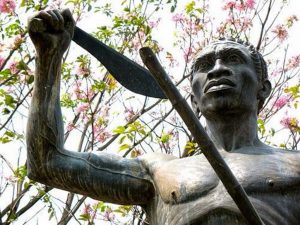
Gaspar Yanga statue.
1570, Gaspar Yanga (born in Guinea) leads a large group of African slaves in escaping Vera Cruz sugar plantations, establishes cimarron village of San Lorenzo de los Negros. Viceroy fails in 1606 and 1609 attempts to halt Yanga’s raids on Camino Real silver trade route from Mexico City. In return for permanent freedom, Yanga agrees in 1618 to end raids on Spanish villages, proclaims loyalty to church and king, and agrees to return future runaway slaves.
1570, Puerto Rican gold streams depleted, reducing demand for slaves. Island evolves into military base (building of main Morro Castle at San Juan begins 1589 with 150 slaves) and stopover for Spain-bound treasure fleets. Slave population slowly declines.
1571, Holy League (mainly Habsburg Spain and Austria, plus Venice) defeats Ottoman fleet in Battle of Lepanto (Gulf of Patras). Each side deploys more than 200 galleys, in this last large battle of rowed vessels. League allies lose more than 7,000; Turks three to four times that number. Twelve thousand Christian galley slaves freed; thousands of Turks taken as slaves.
The sea victory does not end Ottoman wars, but it does curb their expansion into the western Mediterranean, heartening Christians after their long series of defeats.
1572, Francis Drake, with two small ships, allies with black cimarrons and French privateers to sack the Panama treasure port of Nombre de Dios, June. The following April, they ambush a mule train laden with 20 tons of silver from Peru. They drag what they can to their boats and are back in Plymouth, rich, by August.
Drake becomes the first Englishman to see the Pacific. He also persuades one of the cimarrons, a skilled shipwright named Diego, to join his crew.

Luis Vaz de Camoes.
1572, The Lusiads is published in Lisbon. Luís Vaz de Camões’s epic poem tells the story of Vasco da Gama’s 1498 voyage to India. Camões is a soldier and seafarer with long experience in Goa and the Far East. A separate, famous lyric poem tells of Camões’s love for a dark slave.
1572, Targeted killings of Huguenot leaders and mob massacres of families follow the Aug. 24 wedding of Catholic Margaret of Valois (King Charles IX’s sister) to Henry of Navarre, a Protestant, and the attempted assassination of Adm. Gaspard de Coligny, leader of the Huguenots.
Estimates of the dead range from 5,000 to 30,000. The massacre breaks out in heavily Catholic Paris, but ranges to many other cities. Original plot is blamed on Catherine de’ Medici, mother of Charles and Margaret.
Renews France’s Wars of Religion with little respite until the Edict of Nantes is signed in 1598.
1575, Portuguese found small settlement, centered on Luanda at mouth of Angola’s Kwanza river, with 100 families and 400 soldiers. More than a factory or trading fort, this is the first European colony on Africa’s mainland.
Strong trade for slaves and silver develops with the Kingdom of Kongo, whose king nominally converts to Christianity. To the south is the Kingdom of Ndongo, which also deals in slaves, but fights Portuguese for decades to maintain independence.
“Angola” is derived by Portuguese from N'gola, which means “ruler” in these Bantu-speaking kingdoms.
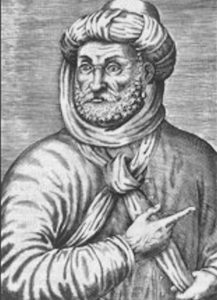 Sebastio I of Portugal.
Sebastio I of Portugal.
1578, Sebastio I of Portugal (an ally of the deposed sultan of Morocco) is defeated in Battle of Ksar el Kebir by the new sultan. Portuguese nobles and military decimated with many killed and thousands taken captive; Sebastian’s body is never found.
In Portugal, aging Henry, a celibate Catholic cardinal, becomes king. In Morocco, Ahmed al-Mansur becomes sultan, benefiting from massive ransoms extracted from Henry for captives.
1579, In Panama, Luis de Mozambique and his band of cimarrons win Spanish governor’s full pardon, freedom and land grant for their community, Santiago de Príncipe. In return, they end attacks, which began with Bayano in 1552, on silver mule trains crossing Isthmus to Nombre de Dios.
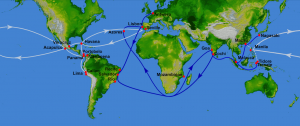
1580, Death of Henry and the following Battle of Alcântara near Lisbon, Aug. 25, lead to Portugal’s dynastic union with Spain under the latter’s Philip II. Portugal is dominated by Spain’s Habsburg kings for next 60 years.
There are many ramifications. Portugal is now forced to align with Spain against both England and the rebelling Dutch provinces. Philip bans Dutch access to Portugal’s spice trade with Far East; Amsterdam loses middle-merchant role to Catholic Antwerp and is hard pressed to finance continuing revolt against Spain.
This leads to persistent Dutch (and later English) campaigns over the next century to take over large parts of Portugal’s overseas empire, with Brazil and the slave trade among their targets, in addition to lucrative Far East spice trade.
One benefit to Portugal: Spain again grants the asiento to Portuguese merchants to provide slaves for Spain’s American colonies.
The forced union does not end until 1640 when João IV takes back Portuguese crown. And conflict with Spain continues after that to 1665.
Slaves are freed: At least 440 black Lisbon slaves win freedom in return for fighting with Portuguese at Alcântara. One source says 3,000 slaves, many from the Lisbon docks, fought.
Between 5,000 and 9,000 die from a yearlong outbreak of bubonic plague, mostly in the island capital of San Cristóbal de La Laguna. It’s the first significant outbreak in the Atlantic islands, but does not seem to have spread to even neighboring Canaries.
1585-1586, Francis Drake leads fleet of 21 ships to raid Vigo (on Spain’s Galician coast) and Santiago (in the Cape Verde Islands), then across the Atlantic to sack Santo Domingo, Cartagena (where he releases 100 Turks held as slaves) and St. Augustine (Florida).
1585, Fleet of 10 English ships, led by Bernard Drake (distant cousin of Francis’s) arrives at St. John’s, Newfoundland, in August, to re-establish England’s claim, to seize Spanish and Portuguese vessels fishing the Grand Banks, and to warn English ships of the war. More than 20 ships are taken, along with 600 seamen and 3,000 tons of dried fish. Still more ships, carrying sugar, wine and ivory, are seized off the Azores. It is a hugely profitable expedition.
Black Assize: 38 Portuguese seamen, infected with what is now believed to have been typhus spread by body lice, are imprisoned at Exeter Castle, March 1586. Most of them die, as do 8 judges, 11 of 12 jurors, several constables and unnumbered townspeople. Bernard Drake succumbs April 10.
1587, At least 112 men, women and children, led by John White, land in July on Roanoke Island in Walter Raleigh’s second attempt to establish an English colony. In August, White’s daughter gives birth to first English child born in North America, Virginia Dare. White is sent back to England to plead for more supplies.
His return voyage to Roanoke is blocked by Elizabeth’s order that all ships remain in home waters to defend against the Spanish Armada. White doesn’t get back until Aug. 18, 1590, his granddaughter’s third birthday.
None of the settlers are ever found, living or dead. The fate of the “Lost Colony” remains unknown.
1588, Felipe II, infuriated by English attacks, sends Spanish Armada of 130 ships to overthrow Elizabeth I and restore Catholicism to England. But Armada is defeated in the Channel by English and Dutch fleets, then scattered by contrary winds and battered in attempting to sail around Scotland and Ireland in brutal weather. Thousands die, but 67 of the better ships make it back.
Retaliatory attack by 150 English ships under Francis Drake is no more successful the following year with 40 ships lost and many thousands dead. It totally fails to ignite an uprising in Lisbon against Spain. Fighting with Spain, spurred by Catholic-Protestant enmity, continues in European waters and in the Caribbean until Treaty of London, 1604.
1588, Portuguese designate Cacheu, near the mouth of the Cacheu river (present-day Guinea-Bissau), as a captaincy. They build a fort and quickly establish a major slave-trading center for the region. Mandinka of the fading Mali Empire are both slave-raiders and enslaved. Jola people are said to resist slave-trading.
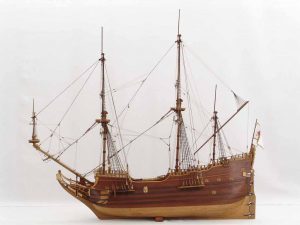
The Fluyt.
c. 1590, Dutch shipwrights in Hoorn develop the fluyt. This new ship design is based on the galleon but doubles cargo space with pear-shaped hull and a continuous main deck. New techniques and tools make it much cheaper to build and easy to sail with smaller crews. They are generally three-masted (with a lateen sail on the mizzen) and draw only a few feet of water. All of which sharply reduce the cost of moving cargo.
The new ships are a major factor in the rapid rise of the Netherlands’ seaborne empire. Less than 100 years later, Dutch ships total 556,000 tons—about half of the European total—even as England and other nations copy captured fluyts.
1591, A small Moroccan army crosses Sahara, then challenges and defeats massive Songhai force of 40,000 at Tondibi (in present-day Mali), March. Muskets and cannon help. Gao, Timbuktu and Djenné are sacked; large amounts of gold sent to Marrakesh by camel, as well as Muslim scholars in chains.
Moroccans are led by Judar Pasha, Sultan Ahmed al-Mansur’s eunuch general. (Born Christian in Spain, Judar had been captured and castrated as a boy by Muslim slave raiders.)
Moroccans eventually withdraw from Songhai lands, 1599, but retain control of lucrative trans-Saharan trade routes.
1595, São Tomé’s mountain maroons join plantation slaves in a major insurrection. Several Portuguese settlers attending a Mass are killed, July 9. Over 20 days of battling the main town is attacked several times by as many as 5,000 rebels; 60 of 85 sugar mills and many plantations are burned.
But fortified settlers and forros hold out with artillery. Rebel unity cracks, with most seeking clemency. Hundreds of slaves die, relatively few whites and forros. The slave leader, Amador, is executed with his lieutenants.
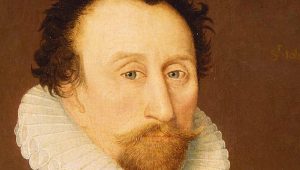
John Hawkins.
1595-1596, Elizabeth I sends John Hawkins and Francis Drake to raid Canary Islands, Spanish Main and West Indies, and to intercept Spain’s treasure fleet. After unsuccessful attacks on Las Palmas (Gran Canaria) and San Juan, Hawkins (who is also searching for his son Richard, a Spanish captive since 1593) dies off Puerto Rico.
Drake then seizes Nombre de Dios and sends a force toward Panama City on the Pacific side of the Isthmus (where sizeable treasure has arrived from Peru). That attack fails in the mountains. Disease strikes down many men and Drake himself dies of dysentery on his flagship off Portobelo, Jan. 29. Retreating warships are intercepted by Spanish galleons near Cuba; only eight of the original English fleet of 27 ships make it back to Plymouth.
Meanwhile, treasure fleet safely delivers 20 million silver pesos to Sanlúcar, the largest, richest payload to date.
1595-1599, The Netherlands’ Cornelis de Houtman leads two voyages to challenge Portugal’s control of the Far East spice trade.
The first voyage departs Texel April 2, 1595 to return in 1597 having lost 162 of 249 men and gaining only a modest cargo in Bali. The second, in 1599, is defeated by Malahayati, the female admiral of Aceh, and De Houtman is killed.
But the Dutch are not discouraged, forming the Verenigde Oostindische Compagnie (known in English as the Dutch East India Company) in 1602.
Spies: Dutch benefit from De Houtman’s earlier researches in Lisbon and from closely held maps and charts copied in Goa by Jan Huygen van Linschoten, a Netherlander who served as a secretary to the Portuguese archbishop of Goa in the 1580s. Van Linschoten revealed all in Itinerario, published 1596.
1596, English fleet with Dutch allies (150 ships together) seizes Cádiz with surprising ease, June 30, and forces Spanish to sink many (empty) ships assigned to the treasure fleet. The city is sacked and burned two weeks later in a stinging and costly defeat for the Spanish crown, which declares bankruptcy before year’s end.
Attempts to mount retialiatory attacks on England are thwarted by bad weather in October and in September 1597.
1598, Juan de Oñate leads expedition of soldiers, priests, families and slaves up the Rio Grande valley into New Mexico, home of perhaps 40,000 Pueblo people living in adobe villages.
Fighting breaks out at the Acoma pueblo where 800 Acoma people are killed and another 500 held captive, Jan. 24. Spanish amputate right foot (or perhaps just a toe) of men and force all into slavery for 20 years.
Santa Fé founded in 1610 by Pedro de Peralta as the capital of the province of New Mexico. Main objective is to convert Pueblo peoples. De Peralta builds a Palace of Governors that still stands.
1599, After burning most of Las Palmas de Gran Canaria, and stopping in Brazil (probably Recife), large Dutch fleet sails east and takes the main town on Portugal’s São Tomé, October. But the commander, Pieter van der Does, and 1,200 of his men succumb to disease over following weeks, forcing survivors to depart. But not before they destroy many sugar mills, further undermining the island’s now-struggling industry. Another 600 Dutch die on return voyage to Netherlands.
Many São Tomé planters emigrate to Brazil in the following years, bringing their sugar expertise.
1599, Benkos Biohó, an escaped slave, forms a maroon army in the Montes de Maria of present-day Colombia and founds the free Palenque de San Basilio. The governor of nearby Cartagena de Indias offers peace in return for Biohó’s promise to accept no more runaways, 1612. Seven years later, in violation of the peace, Biohó is seized in Cartagena, hanged and quartered. But the palenque remains free.
Roots: Biohó is said to have first been captured in the Bissago Islands (off the Geba estuary in Upper Guinea) where his family held high position.
